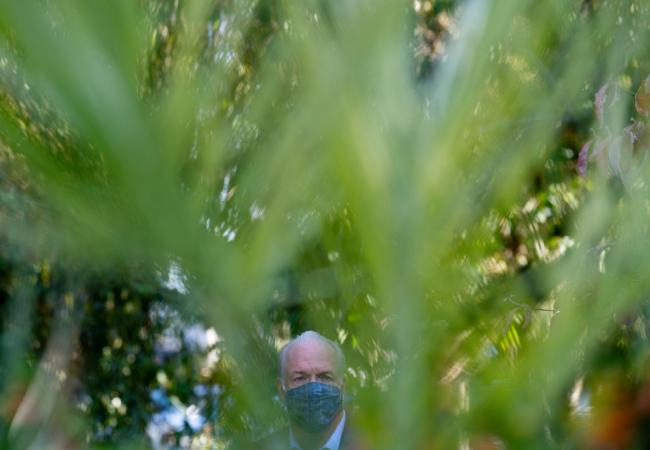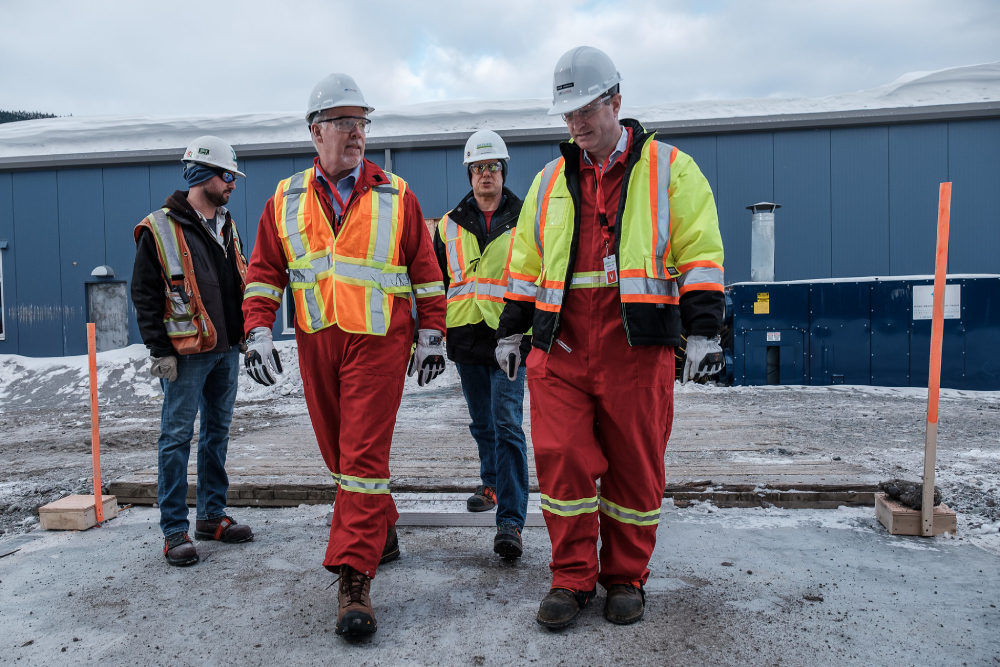Articles Menu

The daunting tale retold of social democrats' dilemma--whether to keep trying to reform what two centuries of evidence shows cannot be reformed or to recognize that the task is to replace the global capitalist socio-economic system before it's too late! And no, I don't think that's going to be simple, which reinforces the urgency. The various scientific deadlines for effective, collective action to counter climate disruption impacts (and other systemic crises) mean we are limited to a half-dozen more electoral cycles.....give or take...
-- Gene McGuckin
Oct. 19, 2021
On Oct. 5, interim BC Liberal Leader Shirley Bond asked in the Legislature why Premier John Horgan’s NDP government failed “to respond effectively to the deadliest weather situation in Canadian history” — last summer’s heat dome.
That minority government yielded the CleanBC plan for reducing GHG emissions and building a more sustainable economy. In 2020, Horgan became B.C.’s first NDP premier to win re-election, his government’s adroit handling of the pandemic helping to deliver a majority.
An emailed summary from the Ministry of Environment and Climate Change Strategy outlines key initiatives since 2017 — shoreline and watershed restoration, enhancement of parks, protection of spotted owl habitat, reduced plastic pollution, initial steps toward climate adaptation, a legislated end to sales of carbon-emitting vehicles by 2040 and sectoral emission reduction targets across the economy, augmenting the CleanBC plan.
All worthy steps, but overall they mostly deal with the “downstream” effects of “upstream” economic carbon bombs, or they set deadlines and emission reduction targets that are too low, too late, and inadequately financed and enforced. B.C.’s climate policies may be amongst the best in North America, but unfortunately that bar is too easy to jump.
The promise of a rapidly greening B.C. on Horgan’s watch has shrivelled like fallen autumn leaves, along with the party’s support from the environmental movement.
Continued old-growth logging has triggered the largest civil disobedience campaign in Canadian history. The stop-pipeline toolbox turned out to have mainly one implement, a long-shot court challenge regarding jurisdiction over bitumen transport. Subsidies for fossil fuel corporations have reportedly doubled over the levels under the B.C. Liberals. The government approved Site C. And it supports fracking and the Coastal Gas Link LNG pipeline — projects that preclude reaching the government’s own goal of 40 per cent emission reductions by 2030, and fly in the face of declining global demand. In support of LNG, Public Safety Minister Mike Farnworth authorized the militarized RCMP raid on Wet’suwe’ten land protectors in 2020.
University of Victoria sociology professor Bill Carroll, co-director of the Corporate Mapping Project, said in an email that the government has weaponized the important principle of Indigenous self-determination, “selectively trotting it out” when it suits the government’s extractivist agenda, as at Fairy Creek.
To explain the B.C. government’s underwhelming and contradictory climate record, start at the top. Horgan is surrounded by senior bureaucrats and political strategists who advise cautious, electorally oriented centrism, or have had direct ties to extractivist industry. One of Horgan’s first appointments in 2017 was Don Wright as deputy minister to the premier — the most senior civil service position. With Wright’s background in both Liberal and NDP governments, and with an executive stint with a major forest company, the appointment could be seen as a commitment to nonpartisan technocratic expertise — but also as an early signal that Horgan wasn’t looking for an administrator to help steer basic changes.
Other senior appointments have revealed rifts within the government along environmental lines. These flashed into view in April of last year, when the premier’s office reportedly fired deputy minister of environment and climate change strategy Mark Zacharias abruptly and mysteriously against the wishes of Environment Minister George Heyman.
A few weeks later, Dave Nikolejsin, then deputy minister heading B.C.’s fracking and LNG strategy, resigned. He had kept his job two years earlier, despite telling an oil and gas audience that a carbon tax, tightening environmental regulations and giving Indigenous nations more say over development could “break the camel’s back.”
Nikolejsin was replaced by former director of the right-wing Fraser Institute Fazil Mihlar. He had been retained after the NDP’s election in 2017 as deputy minister of jobs, trade and technology, notwithstanding his previous public opposition to environmental assessments, the right to organize unions and minimum wage laws. By 2021, he also chaired the board of the regulatory BC Oil and Gas Commission.
Horgan’s own resume reflects the B.C. economy that formed him. To pay for college, he worked in a pulp mill. Inside the NDP governments of Mike Harcourt, Glen Clark and Dan Miller, he “helped troubleshoot key files and was especially focused on energy policy,” a bio reads. Horgan would have lived through the original “war in the woods” in Clayoquot Sound, where the government triangulated between contending interests, but also was rewarded in polls by taking a hard stand against demonstrators.
Such experience seems to have taught Horgan that environmental policy is “all about cutting deals, not pursuing ideals,” says former political journalist Sean Holman.
Basing policy on such political bargaining has profound implications. Actors “who are better resourced, better informed, and strategically located vis-a-vis the centres of policy making have a distinct advantage over socially and economically marginalized groups,” writes Australian political scientist Robyn Eckersley. Haggling between private interests is a major reason “liberal democracies have been unable to deliver more systematic environmental protection.”
In a party with strong ties to labour, Horgan wears proudly his working class roots. He campaigned in 2017 by painting the BC Liberals as the party of the rich “not working for you.”
Before the 2020 election, an NDP MLA privately expressed hope that a majority government might act more boldly on the climate file, but, having discarded the Green Party’s partnership, that seems like wishful thinking.
Since then, the proliferating BC NDP’s donation appeals in my inbox rightly laud social policy achievements like affordable childcare, but rarely if ever mention climate action.
“There’s no evidence that this premier feels the climate emergency in his gut,” concludes Seth Klein, author of A Good War: Mobilizing Canada for the Climate Emergency and former director of the B.C. office of the Canadian Centre for Policy Alternatives, a progressive think tank.
Horgan arguably took another lesson from the 1990s: a fear of a capital strike — that is, a disinvestment campaign by segments of B.C.’s business class until the NDP either capitulates to their demands or is driven out of office. In his memoir, Harcourt recalls businesspeople accompanying his overseas trade missions dissuading their foreign counterparts from dealing with B.C. The lesson? Make sure your policies don’t ruffle too many corporate feathers. That’s one way to interpret Environment Minister Heyman’s commitment to a buy-in from all sectors for the CleanBC plan. And yet, as Klein puts it, any climate plan approved by the fossil sector, with its vested interest in continued extraction, is not a plan worth having.
Fear of capital’s reaction also informed Horgan’s reluctant green light to Site C. He expressed concern that cancellation would jeopardize B.C.’s international credit rating — a claim disputed by independent project financing experts.
Gene McGuckin, a veteran trade unionist, anti-pipeline activist and founding member of the Vancouver Ecosocialists, offers his own explanation.
“Strategically, the NDP is a reformist party, steeped in nearly a century of belief that gradual reform is the only way to achieve significant political victories over capitalism’s damaging, profit-driven policies — whether social, political, or ecological,” he emailed. “Elections are seen as the only mechanism for gaining the parliamentary power to implement such reforms.”
McGuckin says the NDP’s activist members are less conservative than the party leadership, which thus faces a dilemma. It depends on members as donors and campaign troops, and attracts idealists open to radical action — like the rapid decarbonization of Canada’s economy envisaged in the Leap Manifesto, narrowly endorsed by the federal NDP convention in 2016.
But if the leadership is to maintain corporate-friendly policies (especially when in government), left-leaning activists must be kept at arm’s length from real power within the party.
According to the party’s constitution, the BC NDP “shall be controlled by its membership.” In reality, maybe not so much. The premier’s power is reinforced by a buttoned-down culture of intra-party solidarity, arguably greater than that found in the NDP’s federal wing or overseas counterparts like the Australian or British Labour parties.

What prevents the NDP’s greener wing from getting more traction? Confidential sources report that activists seeking nomination to be the party’s candidates in certain ridings, against an incumbent or “establishment” favourite, have sometimes faced informal obstacles, like delays in the required paperwork. As with other governing parties, the promise of future candidacies, jobs or even cabinet posts is a potent carrot to keep ambitious members (including elected MLAs) in the fold. A parliamentary party leader also has heavy sticks, including the rarely used but always present potential to expel publicly dissident MLAs from the caucus.
Troublesome environmental policy resolutions from the grassroots can be procedurally sidelined or ignored even if they are passed.
The provincial council, constitutionally the party’s governing body between conventions, allows ample time to discuss matters like fundraising, but generally sandwiches policy discussion to the end of a time-constrained agenda. One challenging resolution on a moratorium on LNG development, arguably the government’s least climate-friendly policy, was originally developed by several riding associations for the 2019 convention, then successively “lost” from the council’s agenda in 2020, deferred to a later meeting, ruled beyond council’s jurisdiction on the basis of legal advice to the party executive shortly before it was scheduled for discussion, and kicked further down the road to the 2021 convention, where its fate as even an item for debate rests upon the appointed resolutions committee.
As for the federal party’s Leap Manifesto, it was sloughed off to a series of summertime study sessions and thus basically sidelined. But at least, at the national level, the membership had the chance to debate it publicly and to win widespread popular support for its principles.
McGuckin argues some of the industrial unions affiliated to the BC NDP, “afraid for their members’ jobs and only gradually shifting to a more realistic long-view analysis,” have also played a role in weakening the party’s environmental policies.
UVic’s Carroll notes the NDP’s commitment to working people is a prerequisite for both social justice and viable climate action. But in the Horgan-led NDP that effort is “reduced to keeping construction unions onside rather than addressing the labour issue seriously, in a comprehensive strategy for good green jobs, using the full force of the state and the public sector to lead in a just transition.”
Viewed through that lens, the BC NDP can seem a mirage to members galvanized by the climate crisis and the need to protect nature. The party attracts such members (and their wallets) while denying them effective control of its platforms. It pursues modest environmental policies to placate its eco-wing, but without addressing the core problem — the power and vested interests of carbon capital.
As Carroll notes, structural forces underlie the government’s utter lack of “transformative thinking and vision.” A study for the Corporate Mapping Project revealed the size of donations by fossil fuel corporations and industry associations to B.C. political parties — over $5 million between 2008 and 2015, with 92 cents of every dollar going to the BC Liberals, whose return to office could doom effective climate action altogether.
Such political donations, by corporations or unions, were fortunately banned by the NDP in 2017. But carbon capital has many other weapons. Direct lobbying, for one. Between 2010 and 2016, B.C. public office holders heard from fossil fuel lobbyists 19,517 times — about 15 times the volume of environmental groups. NDP Attorney General David Eby introduced modest restrictions in 2017, but lobbying continues.
It’s worth asking how thoroughly carbon capital has “captured” elements of the B.C. state. To see where that can lead, look to Alberta, where author and former MLA Kevin Taft argues Big Oil has so much influence over various institutions — from social media, local businesses and city councils to university departments — that the prairie province has virtually become “Oil’s deep state,” regardless of which party is in office.
The process of institutional capture is less advanced in B.C., but still apparent. The BC Oil and Gas Commission routinely rubber stamps industry applications, argues Carroll, and the ministries of energy/mines and forestry are particularly susceptible to such influence. One avenue: the kind of civil service (dis)appointments noted above.
B.C’s two biggest newspapers, meanwhile, are now owned by Postmedia, Canada’s largest newspaper chain, which has an unhealthily cozy relationship with Big Oil.
Horgan’s incentive to give short shrift to his party’s environmentally focused wing is sweetened by two more factors. The antiquated first-past-the-post electoral system under-represents Green Party voters, typically denying their party the pivotal role that it had from 2017 to 2020. And a colonialist judicial system almost routinely grants injunctions to protect extractivist projects, and privileges settler over Indigenous law.
“Corporate capital really is in the driver’s seat, and it can further enforce its rule through the blackmail of jobs,” Carroll says. “Jobs which may trickle down from profits if policies are pro-corporate but which will disappear if government steps too far out of line.”
That threat seems to be instinctively understood by voters in much of the province. “East of Langley, B.C. is much like Alberta,” says Kam Razavi, climate communication researcher at Simon Fraser University. Maybe that overstates the case, but it’s a useful corrective to stereotypes of a lotus-eating tree-hugging electorate.
Extractivist populism attracts a significant strand of the voting population, especially in the hinterlands where economic alternatives seem scarce. And four decades of neoliberalism, the ideology of free market fundamentalism, has stunted our political imagination and our faith in accomplishing great things together, says Klein. Globally, neoliberalism has undermined the self-confidence and credibility of social democratic parties like the NDP, as they have continually retreated in the face of the privatization juggernaut.
BC NDP strategists girding for the next election find all these reasons and more to avoid serious action on climate change. The emergency’s slow-motion timeframe enables politicians to kick the ball down the road to future administrations. Moreover, the indirect relationship between local emission reduction and global climate mitigation makes it easier to kick the ball sideways — there’s always somebody else to blame, especially if we ignore Canadians’ ignoble status as the highest per capita greenhouse gas emitters on the planet.
Do the same strategists look just a bit farther down the road, however? If so, they might see a party being steered into a ditch. Young people are mobilizing for climate action. The concept of “jobs for the future” in a decarbonized economy is gaining substantial traction within the labour movement, as the realities of ecological crisis and shifting energy markets unfold.
For the NDP, carrying on environmental business-as-usual could carry an electoral penalty. Carroll foresees potential “extensive defection, primarily to the Greens. Some Vancouver Island ridings may shift from NDP to Green, but the main effect will be to split the left-of-centre vote,” yielding a possible majority BC Liberal government.
Here is what I heard from one lifelong NDP voter in Courtenay-Comox, the pivotal Vancouver Island riding where a nail-biting vote count narrowly put the New Democrats into office in 2017. “Some of my [formerly NDP] friends have already moved to supporting the Green Party, provincially and federally,” Deb MacDonald told me. “Some use their vote negatively against a worse alternative. And some don’t bother voting at all because they don’t feel they will be represented.”
On Nov. 19, the BC NDP holds its biennial convention. It’s likely to bring fissures within the NDP membership more clearly into view. Resolutions from local electoral district associations and grassroots policy committees include calls for an end to old-growth logging, a moratorium on LNG development, renewed opposition to the Trans Mountain pipeline, a rapid phase-out of fossil fuel subsidies and a broad-ranging “just recovery” from the pandemic to a decarbonized economy that leaves nobody behind. Will those proposals make it through the gatekeepers to the convention’s floor debates?
Seth Klein, who is sympathetic to the green wing of the BC NDP, is optimistic the party can change. He asks, who could have predicted the federal Liberals would pivot so quickly in response to COVID-19?
And the widespread desire for greater internal party democracy — after all, what does the D in NDP stand for? — provides the basis for a pro-change coalition broader than the eco-wing.
The 12,000-plus members of the BC NDP — a party I first joined in 1971 — are likely the largest and most diverse group of electorally engaged, progressive-minded British Columbians. Historically, the NDP is rooted in the political philosophy of democratic socialism, one relatively well suited to facing the ecological challenge, writes sociologist Mary Mellor. The need “to live within limits and organize a system that can provision the human community” demands that the economy be a matter for democratic decision-making, she argues. The socialist ethos of society’s collective responsibility for human wellbeing needs to be extended to other species and ecosystems, and may now be a condition for our own survival.
Can the party bearing that tradition in B.C. rise to the challenge? Or will it will take a deeper political re-alignment, including mass mobilization, to drive the necessary economic reconstruction?
 Robert Hackett, professor emeritus of communication at Simon Fraser University, lives in Powell River. His most recent co-authored book is Journalism and Climate Crisis.
Robert Hackett, professor emeritus of communication at Simon Fraser University, lives in Powell River. His most recent co-authored book is Journalism and Climate Crisis.
[Top photo: BC NDP Premier John Horgan on the campaign trail last year. His political history showed him environmental policy is ‘all about cutting deals, not pursuing ideals,’ concludes one veteran journalist. Photo by Jonathan Hayward, the Canadian Press.]